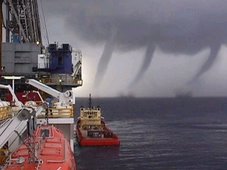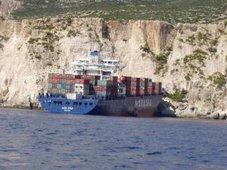 Happy National Weatherperson's Day!
Happy National Weatherperson's Day!BLACKPOOL Attempts to move the stricken ferry Riverdance are unlikely for at least another 48 hours, the vessel’s owners said.
A salvage team was working to reduce the severe listing of the ferry, though efforts were being hampered by weather conditions. Helicopters and lifeboats went out to the ferry during a storm on Thursday, after a freak wave hit the vessel 12 miles out in the Irish Sea. The last of the crew were winched off early on Friday after the ship ran aground near Blackpool. Officials said the priority was to get the fuel out of the bunker tanks. COINCIDENTALLY, just as the reefer vessel Horncliff was losing its container deck cargo in the Western Approaches, marine mutual liability insurer, the North of England P&I club reported in the latest issue of its loss-prevention newsletter Signals that container damage and loss “continues to be a problem”. “Container losses and collapsed stows in heavy weather continue to occur,” says the club’s head of loss-prevention Tony Baker. “Such weather is not altogether unexpected and it has highlighted a number of areas of poor practice that need to be rectified if the industry is to keep a lid on spiralling claims costs.” The club points out that container claims can be particularly expensive. In 2006/7 North of England reported 16 cargo claims estimated in excess of US$1m; only two related to container losses but these accounted for 30% of the total value.
HOW THE DRAMA UNFOLDED
7.43pm - Captain issues a Mayday call saying ship is listing badly.
8pm - RAF rescue crew, the Seacat, based at RAF Valley in North Wales, is put on standby for an emergency rescue.
8.20pm - The RAF crew are scrambled to the scene.
9pm - Everyone on-board the stricken vessel assembles on the bridge and the RAF crew begin winching people to safety.
10pm - Helicopters bringing people to safety begin arriving at Blackpool Airport.
10.50pm - Riverdance runs aground between Norbreck and Cleveleys.
11.15pm - Kevin Hobbs, of Seatruck, tells the media there was no reason why the ship should not have sailed, despite the "atrocious" weather conditions.
4am - Crew remaining on board, unable to get the vessel refloated under her own power overnight, were evacuated from the vessel by rescue.
FREAQUE WAVES
My good friend at Freaque Waves has an excellant write up on both the M/F Riverdance and M/V Horncliff and the media's exaggeration of freak waves.
Paul writes, "I guess the most irritating part of the news reports to me is that they all alluded to the fact that the ferry was struck by a freaque wave, but no one give any details regarding the freaque wave. It was horrendous sea conditions with winds up to 60 mph and big waves all around, if it was may be just caused by one of the large storm waves -- which is entirely possible, then what was there to make it a freaque one?"
Then Pual hits a home run when he says, "Freaque waves are uncertain, but in the winter ocean giant waves are to be expected."
But giant storm waves make for lousy press....
MARITIME NOTES
Container claims going overboard, warns North of England P&I club
‘Container losses and collapsed stows in heavy weather continue to occur,’ says the club’s head of loss-prevention Tony Baker. ‘Such weather is not altogether unexpected and it has highlighted a number of areas of poor practice that need to be rectified if the industry is to keep a lid on spiralling claims costs.’
Container claims can be particularly expensive. In 2006/7 North of England reported 16 cargo claims estimated in excess of US$1 million; only two related to container losses but these accounted for 30% of the total value.
Baker says there are four principal factors behind recent incidents: failure of automatic twist-locks in lashing systems; failure to stow and secure containers in accordance with the ship’s cargo securing manual; mis-declared overweight containers; and failure to anticipate and minimise the effect of heavy weather.
‘All of these factors can be resolved if shipowners and their officers take a more diligent approach to stowing and securing containers,’ says Baker. ‘Problems with fully automatic twist-locks are well-documented and stack heights should be reduced or heavy weather avoided until suspect equipment is replaced. If heavy or high-cube containers form part of the mix, there shouldn’t be a problem if stowage and lashing is done in accordance with the cargo securing manual. Making proper use of the ship’s planning software, and understanding any shortcomings, is also crucial.
‘Mis-declared overweight containers may be spotted by crane strain gauges and can possibly be prevented by closer shore-side monitoring of container stuffing. And finally, with the extent and increased accuracy of weather information and weather-routeing systems today, it should be possible for container-ship masters to amend voyage plans to minimise the effect of heavy weather,’ he says.
North of England currently insures some 310 member groups from around the world, with a total P&I entry of 3000 vessels of 75 million GT (58 million GT owned and 17 million GT chartered). The club is based in Newcastle-upon-Tyne, UK with regional liaison offices in Hong Kong, Piraeus and Singapore.
Contact: Tony Baker or Andrew Kirkham +44 191 232 5221
Like I said we seafarers are superstitious....So today is Super Tuesday and here is the WX report.
RS


































































































![Validate my RSS feed [Valid RSS]](valid-rss.png)